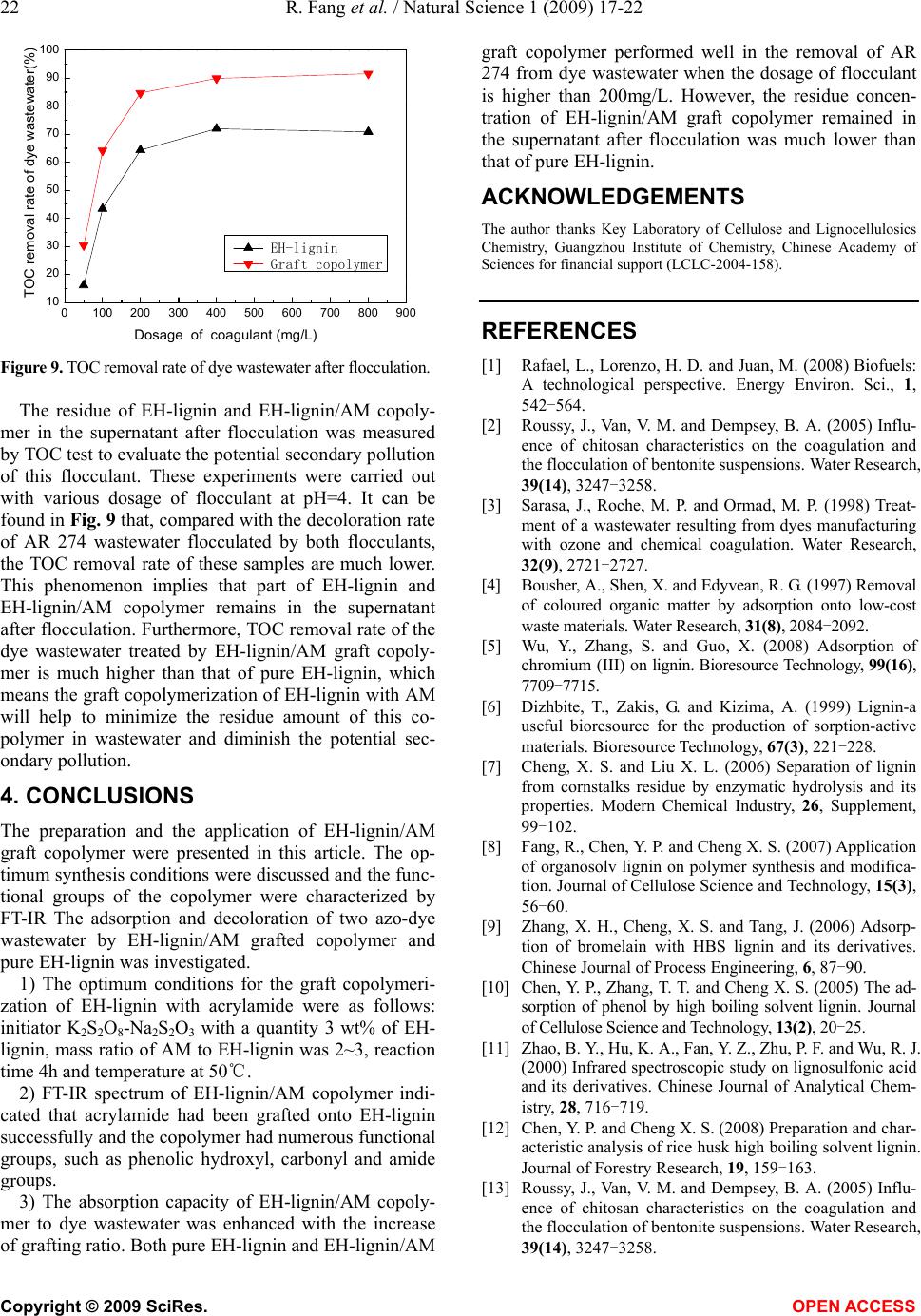
22 R. Fang et al. / Natural Science 1 (2009) 17-22
Copyright © 2009 SciRes. OPEN ACCESS
0100200 300 400 500 600700 800 900
10
20
30
40
50
60
70
80
90
100
Dosage of coagulant (mg/L)
EH-lignin
Graft copolymer
TOC removal rate of dye wastewater(%)
Figure 9. TOC removal rate of dye wastewater after flocculation.
The residue of EH-lignin and EH-lignin/AM copoly-
mer in the supernatant after flocculation was measured
by TOC test to evaluate the potential secondary pollution
of this flocculant. These experiments were carried out
with various dosage of flocculant at pH=4. It can be
found in Fig. 9 that, compared with the decoloration rate
of AR 274 wastewater flocculated by both flocculants,
the TOC removal rate of these samples are much lower.
This phenomenon implies that part of EH-lignin and
EH-lignin/AM copolymer remains in the supernatant
after flocculation. Furthermore, TOC removal rate of the
dye wastewater treated by EH-lignin/AM graft copoly-
mer is much higher than that of pure EH-lignin, which
means the graft copolymerization of EH-lignin with AM
will help to minimize the residue amount of this co-
polymer in wastewater and diminish the potential sec-
ondary pollution.
4. CONCLUSIONS
The preparation and the application of EH-lignin/AM
graft copolymer were presented in this article. The op-
timum synthesis conditions were discussed and the func-
tional groups of the copolymer were characterized by
FT-IR The adsorption and decoloration of two azo-dye
wastewater by EH-lignin/AM grafted copolymer and
pure EH-lignin was investigated.
1) The optimum conditions for the graft copolymeri-
zation of EH-lignin with acrylamide were as follows:
initiator K2S2O8-Na2S2O3 with a quantity 3 wt% of EH-
lignin, mass ratio of AM to EH-lignin was 2~3, reaction
time 4h and temperature at 50.℃
2) FT-IR spectrum of EH-lignin/AM copolymer indi-
cated that acrylamide had been grafted onto EH-lignin
successfully and the copolymer had numerous functional
groups, such as phenolic hydroxyl, carbonyl and amide
groups.
3) The absorption capacity of EH-lignin/AM copoly-
mer to dye wastewater was enhanced with the increase
of grafting ratio. Both pure EH-lignin and EH-lignin/AM
graft copolymer performed well in the removal of AR
274 from dye wastewater when the dosage of flocculant
is higher than 200mg/L. However, the residue concen-
tration of EH-lignin/AM graft copolymer remained in
the supernatant after flocculation was much lower than
that of pure EH-lignin.
ACKNOWLEDGEMENTS
The author thanks Key Laboratory of Cellulose and Lignocellulosics
Chemistry, Guangzhou Institute of Chemistry, Chinese Academy of
Sciences for financial support (LCLC-2004-158).
REFERENCES
[1] Rafael, L., Lorenzo, H. D. and Juan, M. (2008) Biofuels:
A technological perspective. Energy Environ. Sci., 1,
542-564.
[2] Roussy, J., Van, V. M. and Dempsey, B. A. (2005) Influ-
ence of chitosan characteristics on the coagulation and
the flocculation of bentonite suspensions. Water Research,
39(14), 3247-3258.
[3] Sarasa, J., Roche, M. P. and Ormad, M. P. (1998) Treat-
ment of a wastewater resulting from dyes manufacturing
with ozone and chemical coagulation. Water Research,
32(9), 2721-2727.
[4] Bousher, A., Shen, X. and Edyvean, R. G. (1997) Removal
of coloured organic matter by adsorption onto low-cost
waste materials. Water Research, 31(8), 2084-2092.
[5] Wu, Y., Zhang, S. and Guo, X. (2008) Adsorption of
chromium (III) on lignin. Bioresource Technology, 99(16),
7709-7715.
[6] Dizhbite, T., Zakis, G. and Kizima, A. (1999) Lignin-a
useful bioresource for the production of sorption-active
materials. Bioresource Technology, 67(3), 221-228.
[7] Cheng, X. S. and Liu X. L. (2006) Separation of lignin
from cornstalks residue by enzymatic hydrolysis and its
properties. Modern Chemical Industry, 26, Supplement,
99-102.
[8] Fang, R., Chen, Y. P. and Cheng X. S. (2007) Application
of organosolv lignin on polymer synthesis and modifica-
tion. Journal of Cellulose Science and Technology, 15(3),
56-60.
[9] Zhang, X. H., Cheng, X. S. and Tang, J. (2006) Adsorp-
tion of bromelain with HBS lignin and its derivatives.
Chinese Journal of Process Engineering, 6, 87-90.
[10] Chen, Y. P., Zhang, T. T. and Cheng X. S. (2005) The ad-
sorption of phenol by high boiling solvent lignin. Journal
of Cellulose Science and Technology, 13(2), 20-25.
[11] Zhao, B. Y., Hu, K. A., Fan, Y. Z., Zhu, P. F. and Wu, R. J.
(2000) Infrared spectroscopic study on lignosulfonic acid
and its derivatives. Chinese Journal of Analytical Chem-
istry, 28, 716-719.
[12] Chen, Y. P. and Cheng X. S. (2008) Preparation and char-
acteristic analysis of rice husk high boiling solvent lignin.
Journal of Forestry Research, 19, 159-163.
[13] Roussy, J., Van, V. M. and Dempsey, B. A. (2005) Influ-
ence of chitosan characteristics on the coagulation and
the flocculation of bentonite suspensions. Water Research,
39(14), 3247-3258.